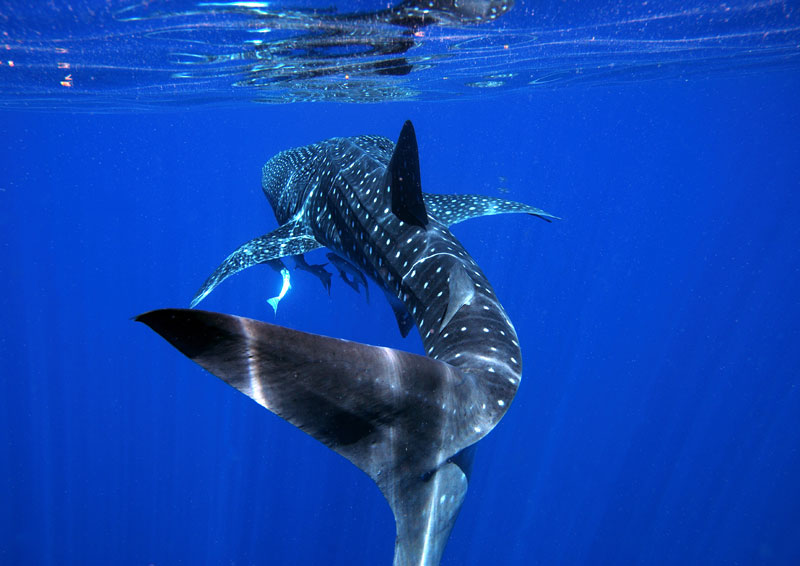Despite its name, the Whale Shark is not a whale but the biggest fish in the world. Huge, beautiful and harmless, this majestic giant can grow up to 18 metres long. Sadly, like many other creatures on earth, the Whale Shark is under threat of extinction, but there is hope, as Dr Stephen Van Mil explains.
The Whale Shark can weigh as much as an amazing 20 tonnes and swimming next to it can feel a little like floating alongside an underwater bus. They have the thickest skin of any animal on earth, with the epidermis measuring up to 10 centimetres. They are one of only three filter-feeding sharks, sucking thousands of litres of water through their large mouth – up to 1.5-metres wide – to extract from the water the plankton, krill and small fish that sustain them.
The sight of one of these giant creatures emerging through deep blue water is a breathtaking and life-changing experience. We humans are completely dwarfed by their sheer size, yet these amazing creatures, as large as they are, are true gentle giants. They spend significant amounts of time gliding slowly along the ocean’s surface, and through their sheer magnificence, they have become an ecotourist’s delight.
Even though the Whale Shark is listed as ‘vulnerable to extinction’ in the World Conservation Union’s red list of threatened species and a growing number of international laws have been made to protect them, these fish are still hunted for their fins and meat.
A Whale Shark’s body is covered in an incredible spot pattern, not unlike a constellation of stars. The spots are like fingerprints and are unique to each shark. It’s this pattern and new technology that is helping to identify their migratory patterns and numbers, which in turn may provide the key to their survival.
Australian marine biologist Brad Norman has been studying whale sharks for the past decade. He’s also the founder of ECOCEAN, a not-for-profit organisation designed to educate and conserve unique marine environments by encouraging and facilitating research for best practice marine management. In conjunction with NASA scientists, Brad developed a unique identification system which uses the constellation pattern unique to each shark as a means of individual identification. This ground-breaking technology led to Brad being awarded a Rolex Enterprise Award in 2006, the first Australian recipient in 25 years to do so.
This identification technology has been combined with the ECOCEAN Whale Shark photo-identification library, allowing Whale Sharks to be identified all over the world. The library has just identified its one-thousandth Whale Shark from a photo sent in by marine biologist Simon Pearce, who is studying sharks and rays in Mozambique.
Whale Sharks were first discovered in 1828 in South Africa, but even today little is known about them. Research thus far has shown that they travel through tropical and temperate waters worldwide, appearing off the coasts of several countries including Australia (at Ningaloo Reef in Western Australia), India, Mexico, the US, Taiwan, northern and eastern Africa, the Seychelles, the Galapagos Islands, the Philippines and the Maldives. Some Whale Sharks have been satellite-tagged and shown to travel 13,000 kilometres across the Pacific and 3,000 kilometres in the Indian Ocean. Most of the whale sharks that visit Western Australia annually are young males.
How far they migrate; to where and why; where they meet to mate; where they have their babies – the answers to these questions are all unknown. It was once thought that Whale Sharks were oviparous, that is, they laid eggs that developed outside the female. However, more recent discoveries indicate they are in fact ovoviviparous; that is, they produce eggs which hatch internally to produce live pups – 300 young were found in one female caught in Taiwan. Although it’s unconfirmed, the Whale Shark’s natural life span is thought to be between 70 and 180 years.
Brad’s research is based largely at Ningaloo Reef in Western Australia, which has become a favoured destination for ecotourists. Every year thousands of visitors from around the world jump into the waters at Ningaloo and glide along with these magnificent giants. Like any interactions with wild creatures, certain rules must be followed to ensure the safety of everyone, including the Whale Shark. For example, divers must remain at least three metres away from the Whale Shark. Underwater photographers or novices wanting to contribute to the ECOCEAN identification project must observe the same rules. Tips for effective identification photos and where to send them can be found at www.whaleshark.org
Swimming with Whale Sharks is an unforgettable experience – we can only hope that through further research, increased knowledge and conservation, they’ll be around for future generations to enjoy as well.
Dr Stephen Van Mil is the founder and CEO of Bryon Bay Wildlife Hospital

